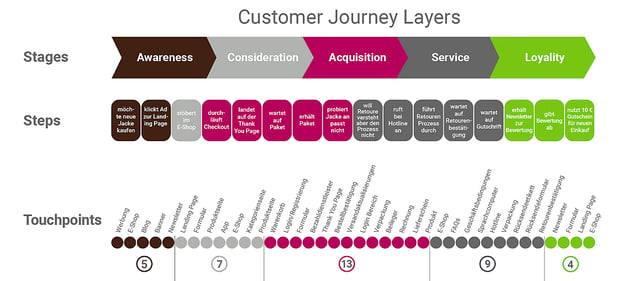*Updated November 2025
B2B purchasing decisions are rarely easy. Companies face lengthy decision-making processes in which multiple stakeholders must coordinate, while the market offers an increasing number of digital channels that potential customers use independently. Traditional sales are increasingly losing influence; according to G2, 60% of B2B buyers conduct their research without ever speaking with a sales team . Personal contact only becomes important in the final phase of the customer journey – and often, by then, the decision has already been made.
These changing conditions present companies with the challenge of optimizing the entire customer journey – not just the final sales phase. To succeed in this complex environment, companies must adapt their strategies: They must be relevant early on, build trust, and adapt their content to the different actors in the buying process.
As a HubSpot Diamond Partner with deep experience in B2B marketing and sales alignment, W4 helps companies in industries such as manufacturing, pharmaceuticals, and software strategically optimize their customer journeys. In this article, we demonstrate how the B2B customer journey is structured, which stages it includes, and which data-driven best practices companies can use to increase their efficiency.
Summary Table: Phases of the Customer Journey
| Phase | Definition | Key Goals | Typical Actions & Content |
|---|---|---|---|
| Awareness | Recognizing a challenge or need | Build brand visibility & trust | Blog posts, white papers, SEO, ABM |
| Consideration | Exploring and comparing potential solutions | Demonstrate value & differentiation | Case studies, ROI calculators, webinars |
| Conversion | Making the final purchase decision | Eliminate friction, support decision-making | Live demos, pricing pages, free trials |
| Loyalty | Post-purchase engagement and relationship development | Drive retention & satisfaction | Success programs, training, check-ins |
| Advocacy | Customer becomes a brand advocate | Encourage referrals & endorsements | Testimonials, referrals, guest articles |
The 5 phases of a B2B customer journey
The B2B customer journey is far more than a linear process. Purchase decisions often take months and involve numerous stakeholders with different priorities. While the awareness phase focuses on gaining a broad understanding of the problem, the consideration phase involves an in-depth exploration of possible solutions. The conversion phase marks the actual purchase, but it is only in the loyalty and advocacy phases that it becomes clear whether a long-term business relationship will develop.
Each of these phases requires a targeted strategy. Companies that actively shape their customer journey not only increase conversion rates, but also customer satisfaction and long-term loyalty.

1. Awareness:
In the awareness phase, companies first recognize a challenge or need, but aren't yet sure which solution is right. They search for general information to understand the problem and rely on available resources such as professional articles, white papers, or industry studies.
- Goal: Build brand awareness and be perceived as a trusted source of expertise.
- Strategy: Search engine optimization (SEO), LinkedIn thought leadership, content marketing and account-based marketing (ABM).
- Content: blog articles, white papers, industry reports, infographics, specialist studies.
2. Consideration:
After understanding their problem, companies begin to compare different solution providers. This is usually where multiple stakeholders make decisions, weighing technical, financial, and strategic aspects.
- Goal: Convince potential customers that your offer is the best solution.
- Strategy: Providing detailed information about the benefits and differentiating features of the solution.
- Content: Comparison tables, case studies, webinars, interactive ROI calculators, product demos.
3. Conversion phase:
The conversion phase is the crucial moment in which prospects decide whether or not to make a purchase. Despite intensive research, uncertainties often remain that can delay the process.
- Goal: To facilitate the purchase decision and reduce any remaining uncertainties.
- Strategy: Clear pricing, personalized advice, proof-of-concept offers.
- Content: Live demos, trial versions, customer reviews , transparent pricing overviews.
4. Loyalty phase
After the purchase, the real work begins – because long-term customer loyalty determines recurring sales and repeat business . Customers expect continuous support, regular optimizations, and a personal contact.
- Goal: To build customer satisfaction and long-term business relationships.
- Strategy: Strengthen customer service, provide training and exclusive offers.
- Content: Customer success programs, webinars for existing customers, upselling opportunities, regular check-ins.
5. Advocacy phase:
Customers who are particularly satisfied with a product or service actively share their positive experiences with others – whether in the form of reviews, recommendations, or reference studies. This organic advocacy is one of the most valuable growth drivers in B2B marketing.
- Goal: To turn customers into active advocates of the brand.
- Strategy: Referral programs, co-marketing with customers, customer interviews and testimonials.
- Content: Case studies, video testimonials, guest posts on company blogs, speaker placements at conferences.

The “Messy Middle” – How B2B customers are stuck between awareness and conversion
After potential customers identify a problem, they intensively explore possible solutions. Instead of a clear, straightforward progression from the awareness to the conversion phase, this process is often unstructured, cyclical, and fraught with uncertainty. Companies compare vendors, gather feedback internally, move between different decision stages, and sometimes temporarily pause the buying process. This complex phase is known as the "messy middle"—a phase in which many potential purchases stall or are even lost.
A key reason for this is the multitude of stakeholders with different priorities. According to Gartner, an average B2B purchasing decision involves six to ten decision-makers, including technical experts, financial managers, and management levels. Each brings a unique perspective to the decision-making process, leading to solutions being continually re-evaluated and discussed internally. While some departments focus on features and functionality, others prioritize business considerations or long-term impact.
In addition, buying behavior has changed significantly in recent years. B2B buyers now conduct research largely independently of sales. According to G2, 60% of decision-makers conduct their research without direct contact with a sales team, and 68% only interact with a sales team in the final decision-making phase .
Michael Buscemi, Director of SMB at G2, goes even further:
"Studies show that buyers are already 60-70% of the way through the buying process before they have a sales contact—and these studies are already 10 years old. I would argue that buyers today are even further along in the funnel and know exactly what they want to buy before a sales team gets involved." (Source: HubSpot Sales )
Companies that fail to establish an early presence through content, targeted touchpoints, and data-driven lead nurturing strategies lose potential customers before a conversation even takes place.
How companies can strategically overcome the “messy middle”
To guide buyers through this phase and reduce uncertainty, targeted measures are required:
- Ensure relevance throughout the entire decision-making process: Companies need to be present throughout the entire “messy middle” with valuable, fact-based content – not just at the beginning or end of the buying process.
- Targeted reduction of information overload: White papers, comparative studies and case studies help to provide stakeholders with clear decision-making bases and facilitate internal discussions.
- Use lead nurturing & retargeting: Automated email sequences, personalized LinkedIn ads , and data-driven retargeting keep potential buyers in the pipeline and prevent them from abandoning the process.
The "messy middle" is a critical phase that determines whether a purchase is pursued or postponed indefinitely. Companies that actively optimize this stage of the customer journey not only increase conversion rates, but also shorten their sales cycles and increase the likelihood of a long-term customer relationship.
Practical example: Rewind – B2B Customer Journey in action
Strategically optimizing the customer journey can have a direct impact on business success. One example is Rewind , a B2B software company that offers cloud data backup solutions. Through the targeted use of customer journey mapping, the company was able to optimize not only its go-to-market strategy but also its target audience, product positioning, and marketing measures.
Challenge: Lack of clarity about customer needs and decision-making processes
Rewind knew there was potential for optimization in the way prospects navigated the buying process. However, without detailed analysis, they lacked a precise understanding of which touchpoints were critical and how different personas navigated the decision-making process. This led to inefficient communication, suboptimal marketing focus, and inaccurate product positioning.
Solution: Customer Journey Mapping for targeted optimization
To address these challenges, Rewind relied on a comprehensive analysis of the customer journey. The goal was to create clear structures for each phase of the purchase decision and align communications to ensure the right messages reach the relevant stakeholders at the right time.
The main measures included:
- Revise the go-to-market strategy to better align with customer needs.
- More precise definition of personas to better adapt content and communication to decision-making processes.
- Optimizing product positioning to more clearly highlight Rewind’s added value.
- Adapting the marketing strategy to target the relevant touchpoints.
Result: More installations & improved customer engagement
The implementation of these measures had measurable effects:
- Product installations doubled as potential customers were guided through the decision-making process in a more targeted manner.
- Improved internal alignment between marketing and sales teams through a clearer definition of ideal customer profiles.
The example of Rewind demonstrates how data-driven customer journey optimization can help companies improve their market penetration and sustainably increase conversion rates. Companies that analyze their customer journey in detail and adapt it specifically can not only increase their conversion rates but also build long-term customer relationships.
Optimizing the B2B Customer Journey with W4
The B2B customer journey is a complex, multifaceted process that extends far beyond the purchase decision itself. Companies need to understand how potential customers research, evaluate, and ultimately make decisions – often over months and involving multiple stakeholders. The "messy middle" demonstrates that B2B buying processes are not linear, and it is crucial to be present and relevant at every stage of the journey.
The example of Rewind illustrates how strategic analysis and optimization of the customer journey can lead to measurable success. Companies that align their processes with data and specifically address the needs of their target audience benefit from higher conversion rates, more efficient market development, and stronger customer loyalty.
As a HubSpot Diamond Partner with many years of experience in B2B marketing and sales alignment, W4 supports companies in specifically optimizing their customer journey. By combining data-based analysis, a customized strategy, and targeted measures, we help you increase your visibility, facilitate purchasing decisions, and build long-term customer relationships.
Take the opportunity to strategically align your B2B customer journey – we would be happy to advise you.










